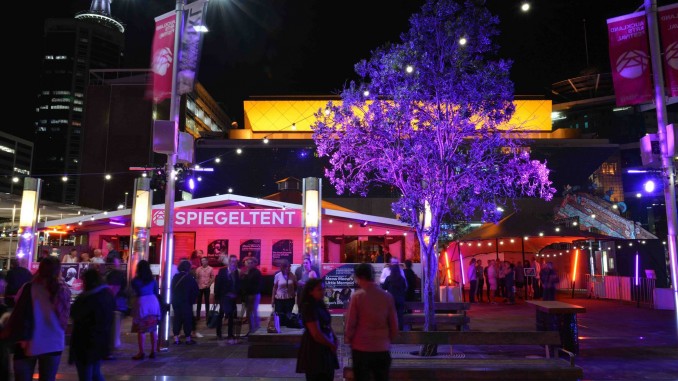
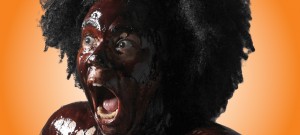
If for nothing else, I’ll personally remember the 2016 Auckland Arts Festival for a kiss.
It was in Tar Baby, when I found myself playing the role of race relations commissioner and sex object. Already I had been called up to the Spiegeltent stage in a group to help re-enact the history of slavery in the Americas, picking up sugar packets, than corralled to help give US Comedian Desiree Burch’s song a chorus line climax.
But now at the end of the show I’d been singled out and called up again. I’m her type: tall, geeky, white. She sets up a sign behind me that reads “kissing booth”. I knew what was coming…
Tar Baby is described as an “interactive carnival of race and capitalism”. Burch acknowledges that it’s a show in which she can commodify and make a spectacle of her blackness, and audiences can can go away feeling liberally worthy. That is part of the transaction. But within it Burch can also explode atomic truth bombs, calling out privilege and unspoken assumptions, particularly around the quagmire of the American experience, but also in our South Pacific nation. There’s comedy, and rage, and a laugh can quickly choke into a gasp. I lurch between elation and seat squirming.
And now at the end, I’m called to kiss and make up. She asks if she can touch my courage, and puts her hand on my chest. She invites me to dance, and sings to me. She says says some awfully nice things. When she offers her lips, how could I refuse?
This was all profoundly moving for me. You might be thinking, here’s the white guy making it all about himself as usual. And I’m going to risk another stereotype – the unloved critic. I haven’t pursued anything romantically for a while, and I suppose I don’t feel attractive all that often, but I did that night. Yes, this is a gag, and an essential part of the show’s structure, but I felt validated. Burch was asking for this too. She wanted someone to look into her eyes. It was a beautiful moment. I beamed.
So there you go Janet, that’s my story.
And there’s many more memories to talk about. I admit, when I first thumbed the hot pink brochure there was little that I felt that excited about. But whenever anyone asked me how my Festival was going, I could hand-on-heart say that I hadn’t really been disappointed by anything. Tar Baby (Nathan Joe reviewed it for Theatre Scenes) was just one of the many treasures contained in the program this year. In Carla Van Zon, we trust.
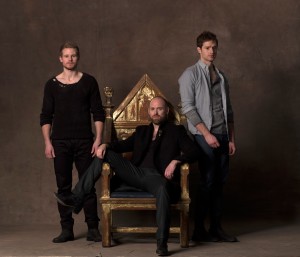
The headliner was The James Plays from the National Theatre of Scotland, which promised a marathon, but time zips by when you’re having fun. We got James’s I through III, but I could easily have kept going through IV, V, and VI (who of course became James I of England). Matt Baker wrote “For New Zealand audiences who are so rarely exposed to epic theatre of such high quality, this is the opportunity to witness the tenacity and skill of one of our many cultural ancestries” and I thought it was “a rare opportunity to see high-quality work with a large scope, both in staging and storytelling”. We also tried something new for Theatre Scenes – a podcast – where Matt and I chatted about our experience of the shows as it happened, checking in over the 9 hours.
We were well served by Auckland Art Festival’s support of local theatremakers. I gave Not in Our Neighbourhood a 9 for Metro. The play was created as a response to playwright Jamie McAskill’s experience of volunteering at Te Whariki Manawahine O Hauraki, the Hauraki women’s refuge, for a year. As Nathan Joe put it, Not in Our Neighbourhood is theatre with a purpose:
Not in our Neighbourhood wants to tell us that domestic violence against women happens all around us, not limited to class, age and racial binaries. As a tool for social awareness, it more than gets the job done. It’s moving, informative and impeccably performed. No one coming out of this play will find the content easy to sweep under the rug. And while it hasn’t quite balanced its artistry with its aims for advocation, it carries an important message that needs to be heard.
I was impressed by The Conch’s Marama, which deals with deforestation across the Pacific, but also in two minds about the work. While breath-taking to watch, I did feel rather lost in the dense forest mist, until the foliage is violently cleared, and the marama stand defiant on traumatised ground. Nathan Joe described the moment:
Towards the end of the play, Marama does something audacious. Something that has to be seen to be believed. The best way to describe it would be to say that Marama commits hara-kiri on stage. The show kills itself, the set, the entire world of the play bleeds to death and peels away its skin, leaving only remains. A moment so visceral, so real, that you can practically feel it reverberate through the entire audience. Even the soundscape alters, conveying the conflict between nature and technology. The women bring something new to their performances here too, desperately defending their land with a sudden urgency. This is one of those breathtaking theatrical moments you’re lucky to see maybe two or three times a year.
We got a new local Opera, Brass Poppies (read Sharu Delilkan’s review), which revisited the ground of Chunuk Bair, to question the way that we remember the Gallipoli campaign. I’ve been thinking about Brass Poppies with the news this week that, after new research, the official figure of New Zealanders who went to Gallipoli has been doubled. It was also newsworthy for the way it used the symbol that we’ve been fretting about, and is now staying for a while longer. I wrote in my Metro review:
The New Zealand flag makes a powerful appearance on the screens, its deep blue, cross of stars, and jack stripes iconic and resonant (for what it’s worth, ferns are nowhere to be seen). But it is not pride we see, but rage. The soldiers denounce nationalism and heroism. Implicitly, if this is a symbol of what they fought and died for, then it is also a symbol of shame. This may yet sway some wavering referendum voters. A soldier is frank: blow your bugles to buggery.
There’s a very good argument too for remembering where you came from – good and bad – and flying it.
Te Pō by Carl Bland was a definite favourite, but I also acknowledge that some working knowledge of NZ playwright Bruce Mason (his characters make an appearance) considerably adds to the experience. Nathan Joe noted:
Te Pō is a play that begs to be unpacked, every object and line loaded with meaning. It’s not difficult to imagine scholars picking at the multitude of references and analysing them obsessively down the line. Sometimes this results in a show that feels overstuffed with ideas, more clever than affecting. But if it doesn’t always engage your heart then, then, at the very least, you can be sure it will engage your head. This is imaginative and ambitious theatre, unafraid to ask the big questions, probing the nature of existence and grief.
I’ve given those scholars a head-start with my primer on Te Pō for The Pantograph Punch, with an extended essay reflecting on the play and the legacy of Bruce Mason.
It is also worth noting that all of these local examples were co-produced by the New Zealand Festival in Wellington. This was the first year the Festivals have overlapped, and both should be applauded for working together to support quality New Zealand work that can foot it with the best of the international program.
Meanwhile, Sharu Delilkan had moments of “despair, confusion and utter frustration” trying to understand NZ Opera’s New Zealand debut of Nixon in China.
We had a number of intriguing visitors. Waves, historical fiction described as a true story. Meow Meow’s Little Mermaid, which didn’t quite achieve its aim of “feminist submersion”. Big Mouth, which channeled famous and obscure speeches from history through the uncanny speaker Valentijn Dhaenens.
While The Chorus; Oedipus from South Korean company Juk-Dal didn’t stray far from Sophocles’s play, the way they physically and aurally told the famous myth was invigorating and inspiring. Nathan Joe reviewed it for Theatre Scenes, and I wrote for Metro:
The chorus move with discipline and precision. Plague ridden, they drag chairs onto the stage, and supplicate themselves in front of Oedipus to save the city. Even here, we see the strength in unity that the chorus possess; Oedipus, solo, is vulnerable. Throughout the chorus are restless, never seated in one place for long. When Oedipus meets the blind prophet Tiresias, they become menacing birds of prey. Dressed in white, they are a swirling hurricane of cloth.
It made me hunger for more New Zealand work to engage in both classical and contemporary stories in this way. For a physical, sports-mad nation, the lyricism of the body is all too rarely unleashed on the theatre stage, though we see it all the time in our dancers. Like The Chorus, a physical theatre Opera, we should explore more cross-over in forms.
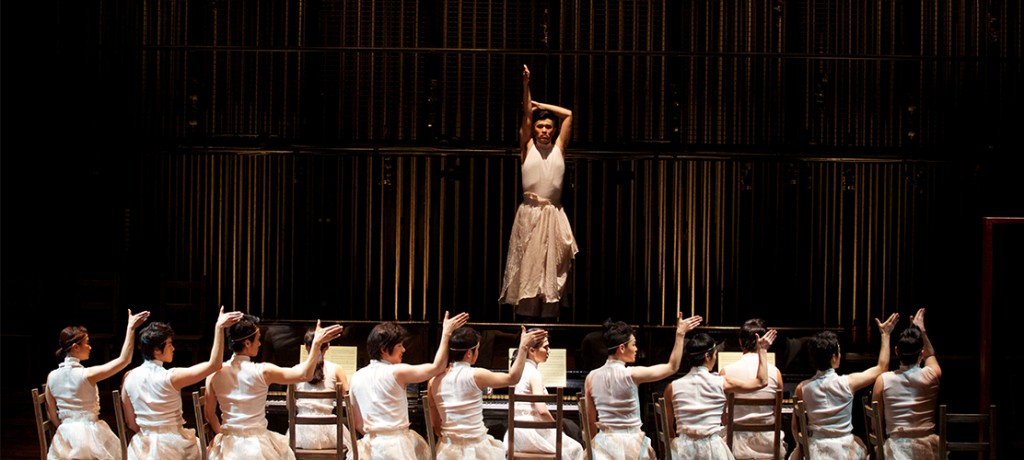
The other lesson we can take is the one from the National Theatre of Scotland and their James Plays. It is surprising to learn that the company is only ten years into its existence. With a population only slightly above ours, their confidence and quality invites day-dreams about what sort of stories a National Theatre of Aotearoa could be empowered to tell, both for ourselves and the globe.
The Auckland Arts Festival has proved the worth of going annual. Bring on 2017. In the meantime, I’ll always have that kiss.

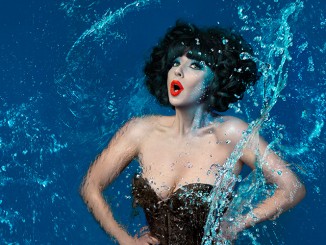
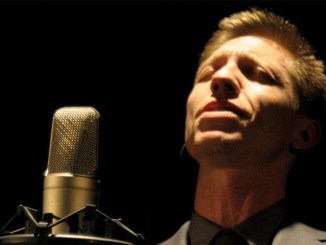
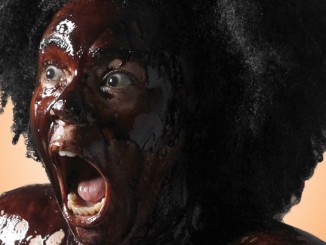
Leave a Reply